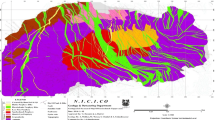Abstract
The seismic slope stability analysis of the right abutment of a railway bridge proposed at about 350 m above the ground level, crossing a river and connecting two huge hillocks in the Himalayas, India, is presented in this paper. The rock slopes are composed of highly jointed rock mass and the joint spacing and orientation are varying at different locations. Seismic slope stability analysis of the slope under consideration is carried out using both pseudo-static approach and time response approach as the site is located in seismic zone V as per the earth quake zonation maps of India. Stability of the slope is studied numerically using program FLAC. The results obtained from the pseudo-static analysis are presented in the form of Factor of Safety (FOS) and the results obtained from the time response analysis of the slope are presented in terms of horizontal and vertical displacements along the slope. The results obtained from both the analyses confirmed the global stability of the slope as the FOS in case of pseudo-static analysis is above 1.0 and the displacements observed in case of time response analysis are within the permissible limits. This paper also presents the results obtained from the parametric analysis performed in the case of time response analysis in order to understand the effect of individual parameters on the overall stability of the slope.















Similar content being viewed by others
References
Bhasin R, Kaynia AM (2004) Static and dynamic simulation of a 700 m high rock slope in Western Norway. Eng Geol 71:213–226
Crosta GB, Hungs O, Sosio R, Frattini P (2007) Dynamic analysis of the Thurwieser rock avalanche, Italian Alps. Geophys Res Abstr 9:1–2
Hatzor YH, Arzi AA, Zaslavsky Y, Shapira A (2004) Dynamic stability analysis of jointed rock slopes using the DDA method. Int J Rock Mech Min Sci 4:813–832
Hoek E, Brown ET (1997) Practical estimates of rock mass strength. Int J Rock Mech Min Sci 34(8):1165–1186
IS 1893 (2002) Criteria for earthquake resistant design of structures. Indian Standard Code by Bureau of Indian Standards. New Delhi, India
Itasca (1995) FLAC Version 4.0, User’s Manuals. Itasca Consulting Group, Minnesota, MN
Joshi A (2006) Analysis of strong motion data of the Uttarkashi earthquake of 20th October 1991 and the Chamoli earthquake of 28th March 1999 for determining the Q value and source parameters. ISET J of Earthq Tech 43:11–29
Liu Y, Li HB, Zhao J, Li JR, Zhou QC (2004) UDEC simulation for dynamic response of a rock slope subject to explosions. Proceedings of SYNOROCK symposium, CD-ROM, paper 2B 23. Int J Rock Mech Min Sci 41(3):1–6
Matsui T, San KC (1992) Finite element slope stability analysis by shear strength reduction technique. J Soils Found 32(1):59–70
Mononobe N, Matsuo H (1929) On the determination of earth pressures during earthquakes. Proc World Eng Conf 9:176
Okabe S (1926) General theory of earth pressure. J Jpn Soc Civ Eng 12(1):311
ROCDATA, 2005. Rock, soil and discontinuity strength analysis. Version 4.0, Rocscience, Toronto, Canada
Singh VN, Mittal A (2005) Synthetic accelerograms for two Himalayan earthquakes using convolution. Curr Sci 88(8):1289–1297
Singh SK, Mohanty WK, Bansal BK, Roonwal GS (2002) Ground motion in Delhi from future large/great earthquakes in the central seismic gap of the Himalayan arc. Bulletin Seismol Soc Am 92(2):555–569
Sriram V, Khattri KN (1997) A study of source spectrum, site amplification functions. Response spectra, fourier spectra, peak ground accelerations from the strong ground motion data of the 1991 Uttarkashi earthquake. Curr Sci 72(10):728–740
Zhang C, Pekau OK, Feng J, Guanglun W (1997) Application of distinct element method in dynamic analysis of high rock slopes and blocky structures. Soil Dyn Earthq Eng 16:385–394
Author information
Authors and Affiliations
Corresponding author
Rights and permissions
About this article
Cite this article
Latha, G.M., Garaga, A. Seismic Stability Analysis of a Himalayan Rock Slope. Rock Mech Rock Eng 43, 831–843 (2010). https://doi.org/10.1007/s00603-010-0088-3
Received:
Accepted:
Published:
Issue Date:
DOI: https://doi.org/10.1007/s00603-010-0088-3




